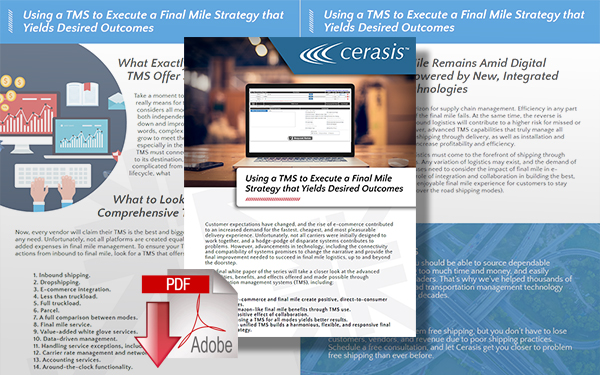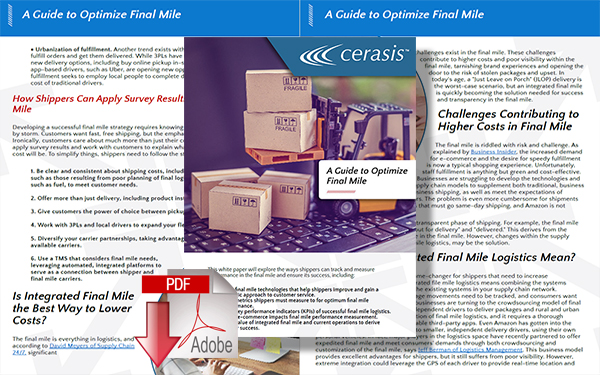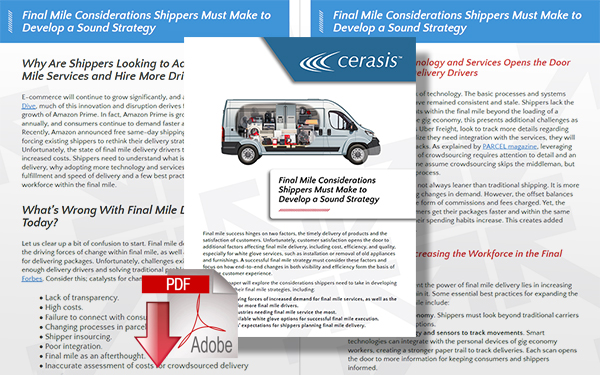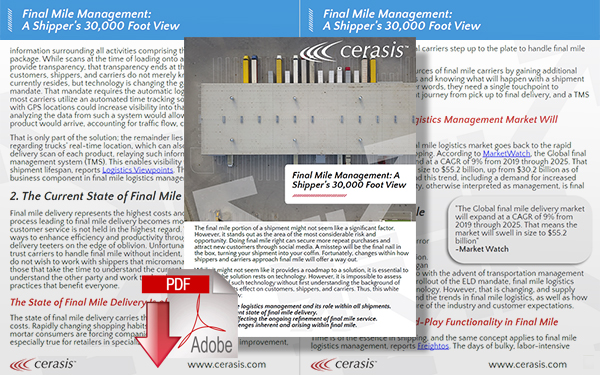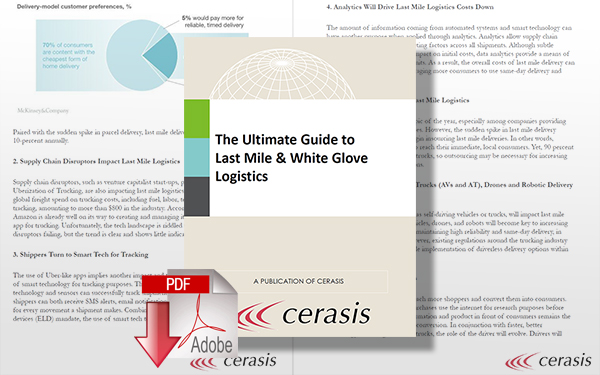The Global State of Last Mile (COVID-19) Distribution in 2020

The only way to survive and thrive in this omnichannel, contactless era lies in understanding the impacts that are reshaping the state of last-mile distribution in 2020 and what it means for supply chain visibility, use of technology, and growth going forward.
Last-Mile Distribution
Global logistics spending will soar beyond $10.6 trillion annually in 2020.
Of that figure, 70% derives from transportation costs, and more than 40% of the transportation costs are within last-mile distribution, reports Material Handling & Logistics.
Yet, the state of the last mile in 2020 is changing to reflect the added surging demand in response to COVID-19 and the pre-COVID expectations for growth in e-commerce, contributing to a $44.88 billion growth in last-mile alone between 2020 and 20254, reports Business Wire.
It’s an unusual circumstance, but then again, disruptions always are.
The only way to survive and thrive in this omnichannel, contactless era lies in understanding the impacts that are reshaping the state of last-mile distribution in 2020 and what it means for supply chain visibility, use of technology, and growth going forward.
Driving Forces of Change in Last-Mile Delivery Through 2020
The driving forces of change in last-mile delivery through 2020 are simple, including a busier-than-average year for hurricane season, the current COVID-19 pandemic, strained trade agreements between the U.S. and foreign countries, limited visibility in the final mile, and of course, the Amazon Effect.
Amazon is the unruly stepchild of shipping, but it is also a paragon of efficiency and always seems to come out ahead. The irony is that Amazon focused on the last mile from the very beginning - delivering to customers with faster, more affordable, and clear shipping capabilities.
As companies look to respond to the disruptions throughout 2020, Amazon’s experiences are invaluable. Take the time to know what your customers want, and if available, build the shipping costs into a service-like offering. You may even realize lower product pricing and reap the benefits of better contracts with your trading partners.
Last Mile Distribution in 2020 Will Be Under the Microscope
A critical concern in the last-mile distribution in 2020 is going to be the “contactless” perspective. Drivers will be more wary and uncertain of whether to interact with customers, and this puts great strain on the need for white glove services. As a result, any failures in the final mile will become evident and result in lost customers. So, companies must put the microscope over final mile logistics, and as other problems come to light, the need for transparency will become a key factor. But, that’s not the full scale of the problem.
Another factor to consider that affects last-mile distribution in 2020 includes the need to move e-commerce fulfillment closer to consumers. Yes, brick-and-mortar stores can be used as fulfillment centers, but they fall short in more ways than one. Additionally, the trucker shortage is resulting in fewer long-haul deliveries and mass problems for shippers.
As a result, companies that work to keep trucker costs under control and move shipping closer to consumers can help to mitigate losses by taking advantage of van and LTL delivery services that can store freight in pickup lockers and third-party sites to give customers more options without adding unnecessary headache to the process.
As explained by Industry Week, “As online retailers are able to fulfill more customer demand cheaply and quickly from local warehouses, they could need much less of one of the most profitable services of the major parcel delivery firms: overnight shipping. Ironically, while Amazon’s investment in Prime Air acknowledges the criticality of overnight delivery today, Amazon’s investments in understanding customer behavior might serve to undermine that criticality tomorrow.”
Listen to “A Look at Final Mile Technology Solutions” on Spreaker.
New Technologies Will Further Unlock Savings Within the Final Mile
The rise of new technologies remains a critical component of the global state of final mile logistics. Artificial intelligence is among these technologies, says Rob Taylor via Forbes:
“In 2020, we’ll see supply chain teams realize the promises of AI, garnering insights on how to improve KPIs like on-time performance and cost to serve. This year, through technology and development in automation, retail supply chains will evolve from being a cost center to an investment for their entire organizations. McKinsey & Company even projects that businesses will gain between $1.3 trillion and $2 trillion each year in economic value by using AI in their supply chains.”
Other functions, like SaaS-based platforms that apply APIs to integrate with existing IT infrastructures, the deployment of machine learning, robotics process automation, and big data analytics, will also make a splash as companies look for ways to squeeze efficiency from the fringe and save money. It all goes back to the need for more omnichannel capabilities, and regardless of where customers get their orders, the final mile is everywhere in some form, even if that final mile rests within your store itself.
Shippers Need to Start Working on Building Visibility Into the Final Mile to Stay Successful
Only time will tell when the next significant disruption will affect the trucking industry, but as 2020 moves forward, shippers must face a simple reality. This is not your father’s supply chain, and the weaknesses in the pre-COVID era will not serve as an excuse for failures to your customers. This is especially true in the final mile - where the most important interaction besides a customer’s completion of a purchase - occurs.
In fact, the trucker shortage may very well come to a head as the pandemic wears on and hurricane season arrives. However, shippers that work to start building the processes to maintain success in the final mile, including increasing final mile transparency, recognizing the state of the last mile market is changing, and implementing a TMS capable of handling last-mile distribution needs, can realize continued success.
Related: Last Mile Health Strategies That Can Help Mitigate Losses During Supply Chain Disruptions
Related White Paper Series
Building the Business Case for Integrated Supply Chain Systems
This educational and informative white paper details how to deploy a usable, flexible, and adaptable transportation management system, or TMS, and how an organization can build the right business case Download Now!
How to Realize the Substantial Benefits of Final Mile Logistics
This white paper, How to Realize the Substantial Benefits of Final Mile Logistics, is a must-read for shippers looking to maximize the logistics of the final mile. Download Now!
Using a Transportation Management System to Execute a Final Mile Strategy
This white paper takes a closer look at the advanced capabilities, benefits, and effects offered and made possible through transportation management systems (TMS). Download Now!
Final Mile Considerations Shippers Must Make to Develop a Sound Strategy
This white paper explores the final mile considerations shippers need to take in developing or rebuilding their final mile strategies. Download Now!
Final Mile Considerations Shippers Must Make to Develop a Sound Strategy
This white paper explores the final mile considerations shippers need to take in developing or rebuilding their final mile strategies. Download Now!
Final Mile Management: A Shipper’s 30,000 Foot View
This is a must-read white paper for those shippers who are looking at incorporating Final Mile Logistics Management into their transportation options. Download Now!
The Ultimate Guide to Last Mile & White Glove Logistics
Shippers must adapt to the changing consumer demands and tailor last mile strategies to mesh well with such demands. In this e-book, “The Ultimate Guide To Last Mile & White Glove Logistics”, details these top lessons that shippers need to know about last-mile logistics in the modern era. Download Now!
More Resources from Cerasis
Article Topics
Cerasis News & Resources
GlobalTranz Appoints Executive Chairman Bob Farrell as Chief Executive Officer Amazon’s Drone Delivery Hits Milestone with Federal Aviation Administration Clearance Digital Supply Chain: The Landscape, Trends, Types, and the Application in Supply Chain Management Walmart’s Bid for TikTok Could Benefit the Retail Giant’s Ecommerce and Advertising Businesses The State of Ecommerce Logistics Heading into 2020 Peak Delivery Season Bringing Omnichannel to the Forefront of Ecommerce FedEx’s Fred Smith Optimistic About Economic Recovery as Ecommerce Business Booms More CerasisLatest in Transportation
Porsche Gets Greener, Shifts to Sustainable Transport Logistics How Much Will it Cost to Repair Baltimore’s Francis Scott Key Bridge? Trucking Industry Pushes Back on Government’s Electric Mandates Maersk Sees Silver Lining in Red Sea Shipping Challenges Baltimore Opens 45-Foot Deep Channel Following Bridge Collapse El Paso Border Delays Cost Juarez $32 Million Per Day in Economic Losses Ranking the World’s 10 Biggest Supply Chains More Transportation




